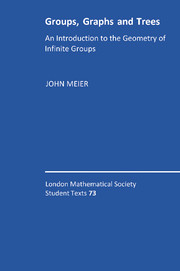Book contents
- Frontmatter
- Contents
- Preface
- 1 Cayley's Theorems
- 2 Groups Generated by Reflections
- 3 Groups Acting on Trees
- 4 Baumslag–Solitar Groups
- 5 Words and Dehn's Word Problem
- 6 A Finitely Generated, Infinite Torsion Group
- 7 Regular Languages and Normal Forms
- 8 The Lamplighter Group
- 9 The Geometry of Infinite Groups
- 10 Thompson's Group
- 11 The Large-Scale Geometry of Groups
- Bibliography
- Index
3 - Groups Acting on Trees
Published online by Cambridge University Press: 05 June 2012
- Frontmatter
- Contents
- Preface
- 1 Cayley's Theorems
- 2 Groups Generated by Reflections
- 3 Groups Acting on Trees
- 4 Baumslag–Solitar Groups
- 5 Words and Dehn's Word Problem
- 6 A Finitely Generated, Infinite Torsion Group
- 7 Regular Languages and Normal Forms
- 8 The Lamplighter Group
- 9 The Geometry of Infinite Groups
- 10 Thompson's Group
- 11 The Large-Scale Geometry of Groups
- Bibliography
- Index
Summary
Eine abstrakte Theorie der diskontinuierlichen Gruppen, die von vornherein darauf abzielt, unendliche Gruppen einzubegreifen, wird in dem Studium der freien Gruppen irhren natürlichen A usgangspunkt finden.
–Jakob NielsenFree Groups
Free groups are central to the study of infinite groups and provide relatively accessible examples that highlight the power of mixing algebraic and geometric approaches. Free groups can be defined in a number of ways. The standard method, which we give in Section 3.1.1, is formal and algebraic. Another common method is to use actions on trees, which is the perspective we develop in Section 3.4. While the formal definition lacks the intuition building power of the geometric perspective, it is often the easiest definition to use when trying to prove that a given group is a free group.
Free Groups of Rank n
Definition 3.1. Let S = {x1, …, xn} be a set of elements in a group, G. A word ω ∈ {S ∪ S-1}* is said to be freely reduced if it does not contain a sub word consisting of an element adjacent to its formal inverse. For example, the word ω = xyx-1y-1 is freely reduced while ω′ = xy-1yxy is not. The group G is a free group with basis S if S is a set of generators for G and no freely reduced word in the xi and their inverses represents the identity.
- Type
- Chapter
- Information
- Groups, Graphs and TreesAn Introduction to the Geometry of Infinite Groups, pp. 54 - 99Publisher: Cambridge University PressPrint publication year: 2008



